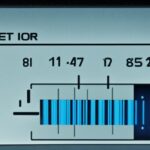Table of Contents
Knowing how much storage your computer has is key to making it work better. Most Windows computers come with at least one hard drive. This is where programs, settings, and files are kept. It’s important to check your storage regularly. Windows makes this easy through the “This PC” menu in File Explorer. You can also use the Settings app for more details.
Understanding your storage limits helps you manage files more effectively. It also makes your computer run smoother. As we explore how storage works and the best ways to manage it, you’ll see why checking your storage often is crucial. This prevents your computer from slowing down and avoids other problems12.
Key Takeaways
- Understanding your computer storage capacity is key to optimising performance.
- Windows offers methods to check storage space easily.
- Regular monitoring can prevent potential slowdowns.
- Knowledge of available storage helps in better file management.
- Each type of storage has unique characteristics impacting performance.
Understanding Computer Storage Basics
Learning about computer storage is key for using and managing data properly. There are two main types of storage devices. These are Hard Disk Drives (HDDs) and Solid State Drives (SSDs). HDDs work by using spinning disks to handle data. On the other hand, SSDs use flash memory which makes them much faster. As technology changes, there are now more choices to suit different needs.
Types of Storage Devices
Storage devices fall into two groups:
- Hard Disk Drives (HDDs) – The most common type for a long time, HDDs store data on magnetic disks. They can use different sector sizes, improving their capacity and reliability.
- Solid State Drives (SSDs) – Built with flash memory, SSDs provide faster access to data. They are becoming more popular because of their performance benefits.
How Storage Capacity is Measured
Storage size is usually in gigabytes (GB) or terabytes (TB). But, the space you can actually use is often less than the advertised amount. For example, a 500GB drive might only have around 465GB available. This is due to how manufacturers and systems calculate space differently. For your info: a kilobyte (KB) is 1,024 bytes, a megabyte (MB) equals 1,024 KB, a gigabyte (GB) is 1,024 MB, and a terabyte (TB) is 1,024 GB345.
In 2025, it’s expected we’ll create 163 zettabytes of new data. That’s a huge increase from 16 zettabytes in 2016. Just in 2020, about 64.2 zettabytes of data were made or copied. This shows how fast the amount of data is growing.
Choosing the right storage is crucial, especially for organisations wanting better data handling. Knowing the different storage types and understanding how their capacity is measured is important. It helps in making the right choices for their systems.
How to Check Your Storage on Windows
Knowing how to check your storage on Windows helps keep your system running smoothly. You can use Windows File Explorer or Windows Settings to look at your storage. Each method shows you how your storage is set up and what needs cleaning up.
Using File Explorer
To find out how much space you have, open Windows File Explorer and click on “This PC”. You’ll see a chart showing used and free space on each drive. Blue shows space that’s been used, and grey shows space that’s free. This helps you quickly see how much space you have left, so you don’t run out.
Using Settings
You can also check storage through Windows Settings. Click the Start button, choose “Settings”, then “System”, and “Storage” to see your storage details. It shows how much space is used and how much is free on all drives. Windows Settings helps you find which files are taking up a lot of space, making it easier to clean up and keep your storage efficient6.
If you’re serious about tracking storage, Windows Performance Monitor is the tool for you. You can track disk usage in real-time with a Data Collector Set. It even lets you save the data in different formats, like CSV files for Excel6. This gives you the power to monitor your storage in detail, choosing to view it in megabytes or as a percentage of the total7.
How to Check Your Storage on Mac
Knowing how to check storage on a Mac helps users manage their devices better. It’s easy to access storage details. This keeps performance high and helps manage free space.
Using the Apple Menu
To start, users click the Apple menu at the top left corner. Then, by selecting “About This Mac,” they get key hardware data, including storage info. Moving to the Mac storage tab, a visual shows the storage used by different file types. This helps quickly find which files or apps to focus on to better use space on the Mac.
Utilising the Storage Tab
The Mac storage tab is great for keeping an eye on storage. Checking it often is advised to keep your Mac running smoothly8. The macOS feature shows a graph of storage capacity and offers tips to boost performance. Knowing how much space system data takes, about 20 GB, is crucial9.
How Much Storage Do I Have on My Computer?
Knowing how much storage your computer has is crucial. Different operating systems need different amounts of space. For example, Windows 11 needs 27GB and MacOS Monterey requires about 25.24GB10. If your computer doesn’t have enough space, it may run slowly. It’s important to frequently check your storage, especially if you store many photos and videos.
A standard 12MP photo from a smartphone might be 2-3MB, while a 108MP picture can be 10-12MB10. Videos take up more space. A 30-second video in Full HD could be around 50MB, and the same video in 4K might need 130MB10. When it comes to speed, SSDs are faster than hard drives, with speeds up to 2,400MB/s10. This shows why it’s key to understand how much storage you need.
To ensure your system runs well, knowing your storage limit is useful. For basic tasks, 256GB might be enough. But if you use large programs or save lots of files, consider 512GB or more10. Checking your storage regularly can greatly boost your productivity.
Doing frequent storage checks lets you know when it’s time to clean up your computer. This keeps your computer running efficiently. It ensures your system is always ready for your tasks.
Managing Your Storage Efficiently
Managing storage well is key to making your computer work better. It’s good to regularly clean out unwanted files. The Windows system helps you see how much space you have and how much you’ve used11. Deleting old files with Disk Cleanup can make your computer run smoother11.
Deleting Unnecessary Files
Getting rid of apps you don’t use can also help free up space11. Keeping your storage tidy means your important files are easy to find.
Using Cloud Storage Solutions
Cloud storage can greatly improve what you can do. With OneDrive, you can store files online and keep your local space free11. This lets you access your files from anywhere while keeping your computer organized.
Upgrading Your Storage Hardware
If you need more space, think about upgrading. Switching to faster SSDs or larger drives is an option. It’s shown that SSDs work best when at least 25% free, different from older hard drives which are fine at 10%12. Knowing this helps plan your upgrade.
Taking steps to manage your storage can keep your system fast. Cleaning files, using cloud solutions, and upgrading when needed helps a lot1112.
Conclusion
Understanding and managing your computer’s storage is key for its best performance. Checking your storage regularly helps spot and fix problems. These might come from big files, apps, and temporary stuff. Using options like cloud storage or tools like EaseUS Partition Master makes your system work better and saves space13.
Different ways to check disk space help you stay on top of your storage. In Windows, you can look in the Settings menu. For macOS users, the Apple menu is your go-to. Knowing your disk space helps with planning and boosts your computer use14.
Keeping an eye on storage is not just useful, it also avoids the annoyance of running out of space. By monitoring well and organising, you’ll change how you manage storage. This ensures your computer stays fast and reliable.
FAQ
What is the difference between HDD and SSD?
HDDs work by spinning disks to read and write data. SSDs, however, use flash memory. This makes SSDs much faster at accessing data.
How can I check the available storage on my PC?
On Windows, use File Explorer to see your drives visually. Or, check the Settings for detailed space info on each drive.
Your device’s total capacity is often more than the usable space. System files and formats take up space. For example, a 500GB drive might only have about 465GB free.
How do I check my storage on a Mac?
Click the Apple menu in the top left corner, then “About This Mac.” Go to “Storage” for a summary of your space.
What are effective strategies for managing my computer’s storage?
To manage storage well, delete old files often and use cloud storage. Consider a hardware upgrade if you need more space.
How often should I assess my computer’s storage?
Check your storage every few months. It keeps your system running smoothly and avoids sudden space shortages.
What should I do if my storage is running low?
Delete apps and files you don’t need anymore. Move stuff to the cloud. Or, get a bigger or faster storage option.
Source Links
- https://www.businessinsider.com/guides/tech/how-to-check-windows-storage – How to check your Windows computer’s storage space in 2 ways, and see how your data is being stored
- https://www.wikihow.com/Check-Your-Hard-Disk-Space – How to Check Your Hard Disk Space: PC, Mac, & Smart Phones
- https://www.techtarget.com/searchstorage/definition/storage – What is computer storage and how is it used?
- https://www.geeksforgeeks.org/understanding-file-sizes-bytes-kb-mb-gb-tb-pb-eb-zb-yb/ – Understanding file sizes | Bytes, KB, MB, GB, TB, PB, EB, ZB, YB – GeeksforGeeks
- https://www.cnet.com/tech/computing/digital-storage-basics-part-1-internal-storage-vs-memory/ – Digital storage basics, Part 1: Internal storage vs. memory
- https://superuser.com/questions/749770/windows-how-can-i-see-disk-space-used-over-time – Windows: How can I see disk space used over time?
- https://www.lifewire.com/how-to-check-free-hard-drive-space-in-windows-2619187 – How Much Disk Space Do You Have Left? Here’s How to Tell
- https://mackeeper.com/blog/how-to-check-storage-on-mac/ – How to Check Storage on Mac
- https://macpaw.com/how-to/check-storage-on-mac – No title found
- https://www.makeuseof.com/how-much-data-storage-do-you-need/ – How Much Data Storage Do You Need on a Computer in 2023?
- https://support.microsoft.com/en-us/windows/tips-to-free-up-drive-space-on-your-pc-4d97fc4a-0175-8d49-ac2f-bcf27de46d34 – Tips to free up drive space on your PC
- https://superuser.com/questions/1256074/how-much-space-to-leave-free-on-hdd-or-ssd – How much space to leave free on HDD or SSD?
- https://www.easeus.com/partition-manager-software/check-disk-usage.html – How to Check/View Disk Storage/Usage on Windows 10/11
- https://www.diskpart.com/windows-11/how-to-check-total-hard-disk-space-in-windows-11-0825.html – How to Check Total Hard Disk Space in Windows 11, 10, 8, 7?








